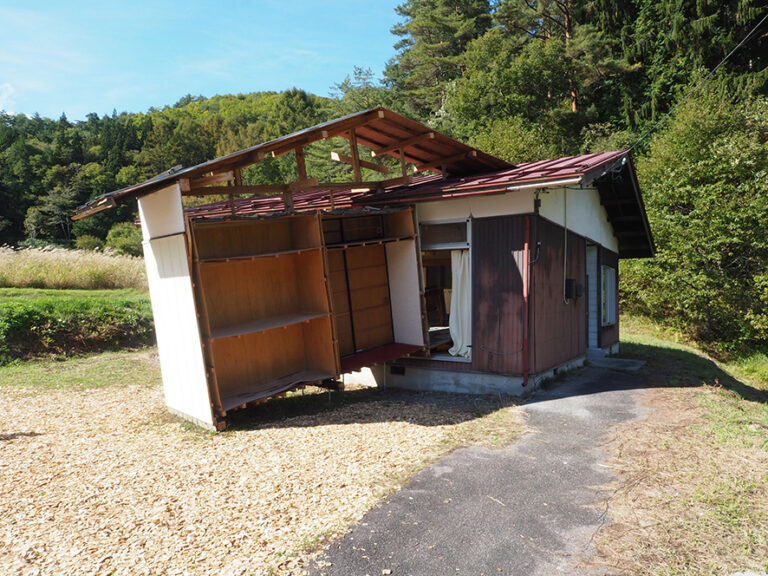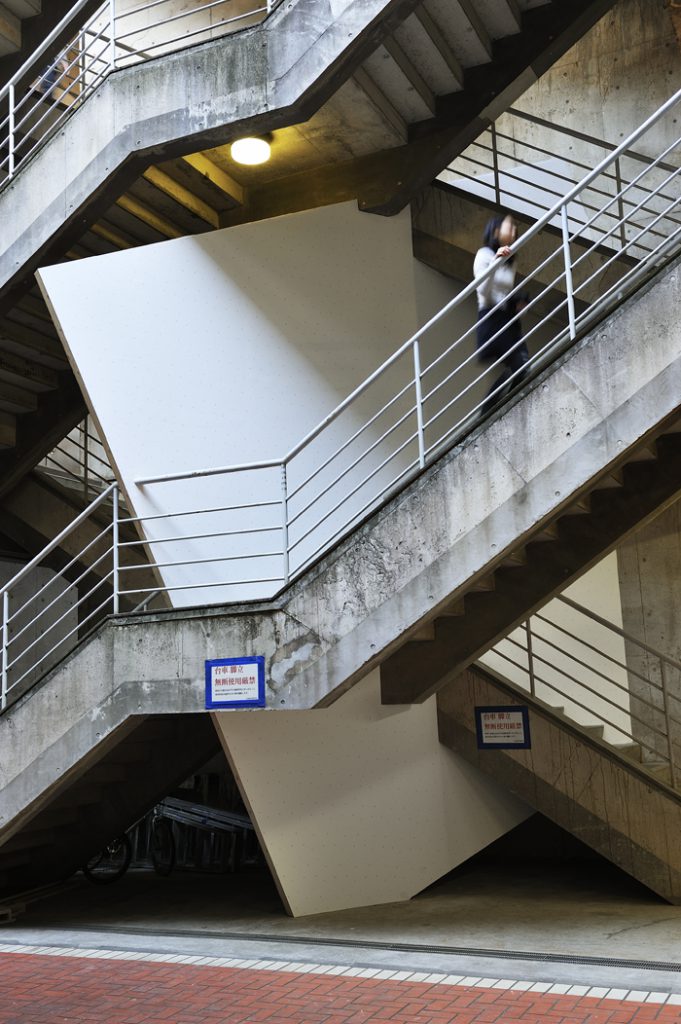1989年、東京生まれ。既存の空間や建物に障害物、増設物などを持ち込むことでパブリックとプライベート、内と外、上と下などの関係を反転させる作品を手掛けるアーティスト。通常、空間のもつ特性から私たちは空間の用途を推測するが、持田の作品は二者の関係を分断、或いは逆転させることによって、日常あたりまえのように考えている空間やものの機能の意味を再発見させる。
主な展覧会 Selected exhibitions
- 2021 "Steps", TERADA ART AWARD, finalist exhibition, Tokyo
- 2021 - Open Storage 2021, MASK [MEGA ART STORAGE KITAKAGAYA]、Kitagaya Creative Village, Osaka
- 2021 "Clash (or the Rift)" / Norther Alps Art Festival 2020-2021 (originally planned to be opened in 2020.
- 2021 "The Revolving House of T.", last public view, Mito, Ibaraki Prefecture
- 2020 Sapporo International Art Festival 2020 (Canceled due to Covid-19)
- 2020 "Distance / Space / Position", group exhibition "“Sazaedo Hall 2020 – Contemporary spiral and 100 paintings”, Ota Museum and Library, Ota City, Gunma Prefecture
- 2019 "Floating House", Reborn-Art Festival 2019, Miyagi Prefecture
- 2019 "Steps", Zou-no-hana Park, Zou-no-hana Terrace, Yokohama, Kanagawa Prefecture
- 2019 "How it (un) happened" , 3331 Art fair、3331 Arts Chiyoda, Tokyo
- 2019 "Floating Room 1, 2", PILOTENKUECHE Leipzig, Germany
- 2018 The further you go, you may fall or you may learn: Japan-Cuba Contemporary Art Exhibition, Spiral Garden, Aoyama, Tokyo
- 2018 The further you go, you may fall or you may learn: Japan-Cuba Contemporary Art Exhibition, Centro de Arte Contemporaneo Wifredo Lam, Havana,Cuba
- 2017-2019 "The Revolving House of T.", Mito, Ibaraki Prefecture
- 2016 "Push the Wall", ZK/U, Berlin, Germany
- 2016 "Crack", Universe 69、co-ume lab., Tokyo
- 2015 "Piercing The Prison, ex-prison in Weimar, Germany
- 2015 "The Cellar", Universe 69, The Gallery of Mariam and Eranuhi Aslamazyan Sisters Gyumri, Armenia
- 2014 "Dig that Snow", elementary school in Sapporo, organized by AIR Planning, Sapporo, Hokkaido
- 2014 "Under the Floor", Rokko Meets Art 2014, Hyogo Prefecture
- 2013 "Seaside Hotel", distorted hotel in Shodoshima, Kagawa Prefecture
- 2013 "Wall", graduation exhibition at MFA, Musashino Art University, Tokyo
About the Artist
preface
Many art projects which had be postponed due to Covid-19 for few months from the spring season of 2020 gradually started to be opened by the Autumn season of 2021. I was able to see number of exhibitions in a short period around that time and found new interesting artists. Above all, two projects done by Atsuko Mochida were very impressive and looked very fresh. The artists has already shown us several types of different works in her relatively short career so far, and I would like to like to consider here the underlying theme and basis of this artist by looking back her works basically in a chronological order. But before we begin, I would like to start from completely different scenery I saw more than ten years ago, as the impression of the scene was somehow close to what I felt seeing the two projects of Mochida "The Revolving House of T" in Mito and "Collison (or a Rip)" in which I encountered in 2021.
On March 12, in 2011, the day after the Great East Japan Earthquake, there was also a large earthquake in the northern part of Nagano Prefecture and its neighboring part of Niigata Prefecture. This incident would normally have been big news if it were not for the historically large turmoil of the Great East Japan Earthquake. But the earthquake which is now been called "Northern Nagano Prefecture Earthquake" was large enough to completely destroy many houses in the area. It was a an extraordinary days and weeks at that time, with the aftereffects of the disaster, and naive time for all the people feeling stress and anxiety.
I had an opportunity to drive around in a countryside of Niigata Prefecture in Autumn of 2011 and encountered a construction site where I felt uneasiness. Many traditional old houses in Japan have pillars placed on top of the cornerstones without been fixed. Therefore, the house may fall off from the stones when they were hit by a strong shake. What I saw at the construction site was reparation of the structure of one house, while lifting the house about two meters off the ground. Instead of placing it back on cornerstones, they were intending to make a new concrete foundation underneath to anchor the house on the ground.
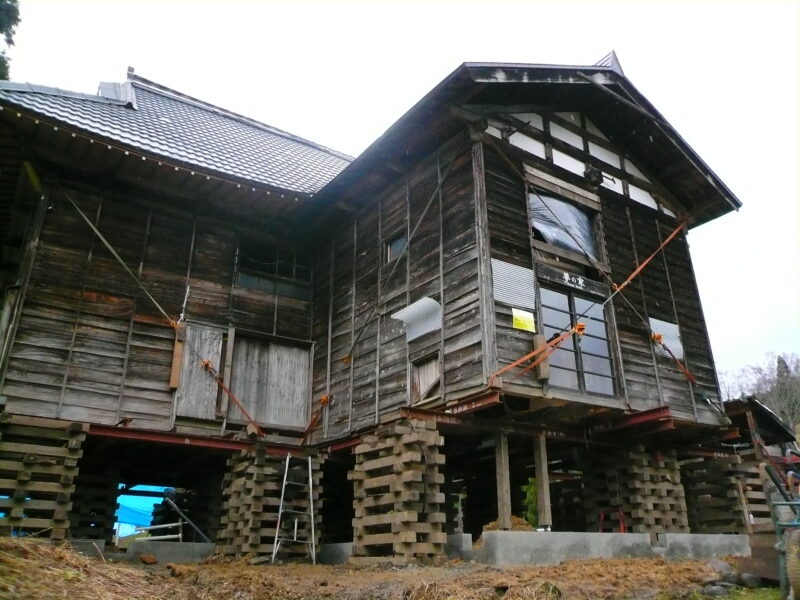
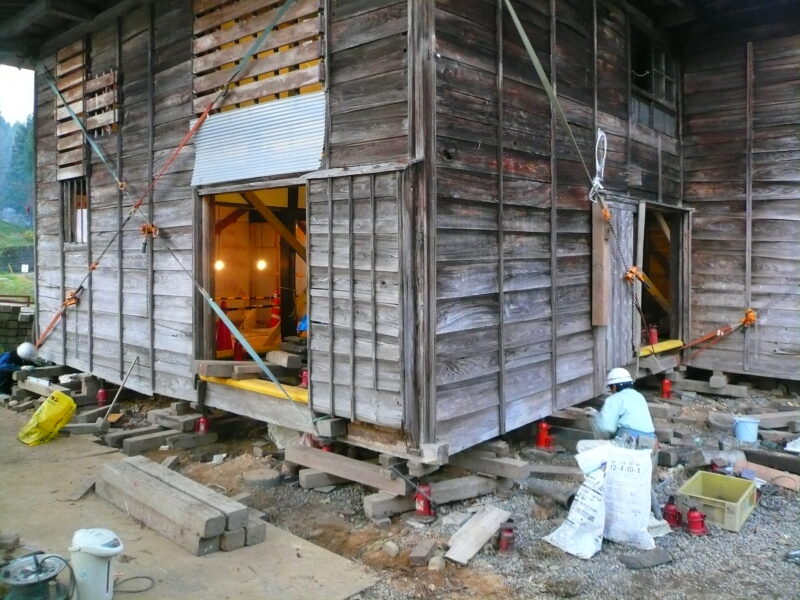
The house is an old house called "Dream House", an exhibition site where Marina Abramovic has worked for Echigo-Tsumari Art Triennale. Though its interior space has already been changed as an work of art, been cut off from the everyday life, but still, its appearance from outside reminded me of the everyday life inside when the house was still an ordinary old house. The scenery was strong enough for me to feel the vibration of my heart feeling a strange anxiety in front of the "floating house" floating in the air like a ghost of an ordinary life of the past. Ten years have passed since then, but when I saw Mochida's work, the similar kind of impact struck my heart and recalled the old house in Niigata. The strong impression of what I saw, must be due to the struggling two impacts, visible and invisible, visual outside and invisible inside or the impression, synergistic effect creating new forces and sensation which the object themselves originally do not contained. By creating the new force, invisible magnetic field is created as the work of art. This may be where the artistic creativity of this artist lies on.
Atsuko Mochida graduated from Department of Japanese Painting, Musashino Art University in 2013. After spending a year at the Department of Intermedia Art in Tokyo University of Arts from 2014, the artists departs Japan to Germany for a year as an exchange student. Since 2015, she has been enrolled in MFA, Public Art and New Artistic Strategies at Weimar Bauhaus University in Germany, where she received a degree in 2018. In recent years, she has been invited to large-scale exhibitions such as Reborn-Art Festival (2019), Sapporo International Art Festival (2020)(*2), and in 2021 she was invited to MASK (MEGA Art Storage Kitakagaya) each of all receiving positive acclaims. All the works challenges our common understanding of usual spaces in architecture, crossing over our definition of public and private, or the work and the viewers. Her projects replaces the condition of houses, walls, and floors with unusual setting and presents an work which is very stimulating and overwhelming.
Early Activities: A Wall
Such characteristics of Mochida's works is already relevant in her earliest work exhibited in 2013 at her graduation exhibition from MFA, Musashino Art University. During this exhibition, the staircase of the university building was blocked by a 6 meter wall. The size of the wall as well as its wall paper was similar with her own ("girlish", if we borrow the words from the artist) bedroom. In other words, the artist own "private" was intruding the public to block people's way, forcing passers-by to turn around to find different passage. Seeing the photo of the exhibition at that time, the wall sharply sticks into the wall grasping the stairs and handrails as if it was there from the beginning, but at the same time, sitting there brusquely unnatural with a great impact.
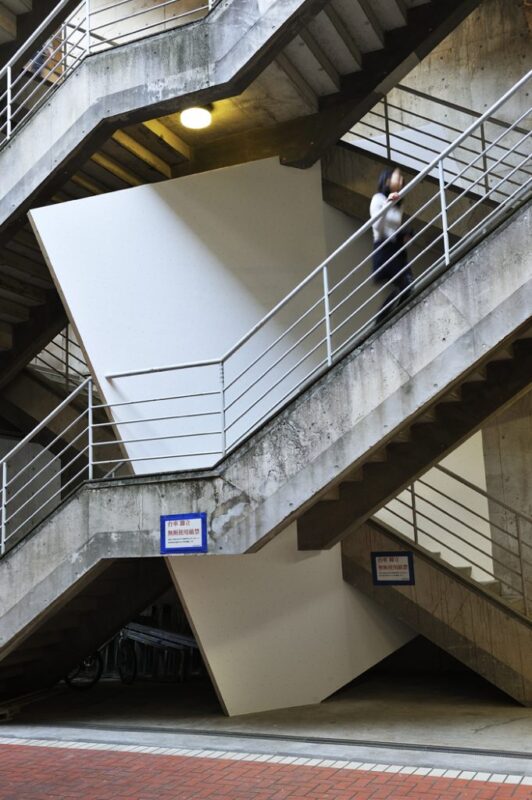

Rokko Meets Art 2014 was the artist's first participation in a major off-campus exhibition. As she selected a staircase in her previous exhibition at the university, she used the staircase this time as an object to intrude to the public café space. The artist used ordinally steel scaffolding pipes found in construction sites to make a structure like an spiral staircase from the café reaching up to a space imitating a private living room.
Years in Germany
From 2015, the artist stayed in Germany at MA Public Art and New Artistic Strategies in Weimar Bauhaus University. Named after Bauhaus, the university is an national school opened in 1996 using the same building which Bauhaus started its initial activities in 1919. The school of Public Art and New Strategies is known as a cross-disciplinary course covering wide range of working fields in Bauhaus. It is interesting that the artist who has made several innervations with the staircase chose Bauhaus, also known for its beautiful staircase (*3 ) designed by Henry van de Velde. It should have be very compatible for the artist to be part of this MA course which is working in an attempt to cover wide range of fields such as architecture, design, design, etc. And it is true that Mochida's works expanded to wider range of new strategies during her stay in Germany.
Among the projects she realized in Germany, she did a site-specific work ”Piercing the Prison” in 2015 at ex-prison building in Weimar. In the project, she made a large ring penetrating the wall of the prison cell and the outer wall. "Piercing the Prison" The trace of destruction, the intervention to the existing building may remind us of Gordon Matta-Clark in 1970s', and here, Mochida is using the tension of the old building, its history as a part of the work, in order to raise the tension of the work as well. The ring is hold the building tightly like a handcuff on the wrist. We are sensing its tension looking at the holes which may crumble and fall off if one may try to touch and loose the bind.
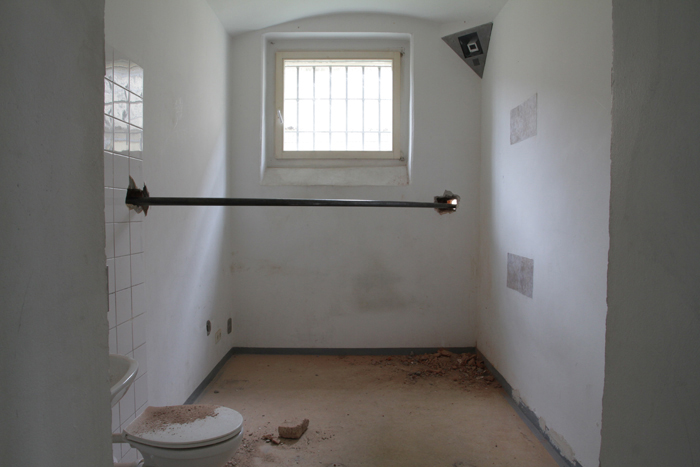

In 2016, a work called "Pushing the Wall" was exhibited at the open studio in residence at ZKU in Berlin. In the exhibition, the artist installed a wall right inside the entrance door of the gallery space. On the wall, there was an instruction from the artist saying "There is a small room. If you need more space, try to push the wall". Following the instructions, audience were urged to work together to push the wall without knowing the result until they hear a sound of glass breaking inside, and see water flowing out from under the wall. In the end, the audience would understand that they were collaborating to destroy a small private room hidden backside of the wall. Here in this work, the relation of public and private was again focused in the work like the artist's initial work "the Wall", but somehow in a reversed way. Audience was taken as part of the work for the first time as the active public, interfering the private. The act of "pushing the wall" will also be developed into different projects and becomes important method for the artist later on such as in ”The Revolving House of T." or exhibition in Art Museum & Library in Ota (2020) and the exhibition in Mega Art Storage Kitagagaya (2021).
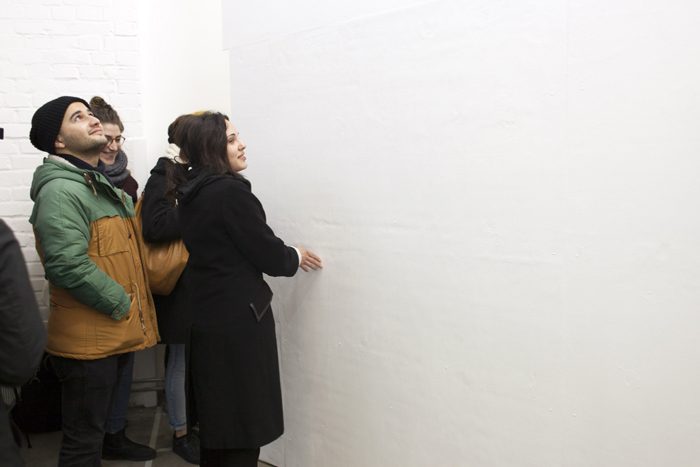
The Revolving House of T. and other Recent Projects
There was another project in Japan gradually stared while the artist was staying in Weimar. The project started in an old wooden house in Mito, Ibaraki Prefecture. The project would be called "The Revolving House of T." and contains many different features of the activities the artist has worked till that day. The artist cut the center of the house in a circle, 5 meters in diameter from the floor to the ceiling, and made it possible for the audience to rotate. The house was where the artist's grandmother lived for a long time, and the artist lived with the grandmother for a while to make a research of the history of the house. We frequently find traces in traditional houses how it grew together along with people actually lived in. They sometime will be expanded to make new rooms for children, and as they grow up, there will sometimes be another renovation. When we look at the structure or material of houses, we can find added material or replacements, how the carpenter tried to solve the detail when intervening to the house by applying a different element to the pre-existing structure. This time, as for Mochida's project, it was an intervention of the artist to the existing architecture. I imagine that the project was almost like the final "renovation" for this house, tracing the history of its past-renovations and finding the right way to add new structure. It was also a large leap for the artist's working method this time, as the role of the artist was more on the whole research and planning, and having specialists and workers collaborating the project, the work was made possible to become a larger project which was not possible for the artist to realize previously.

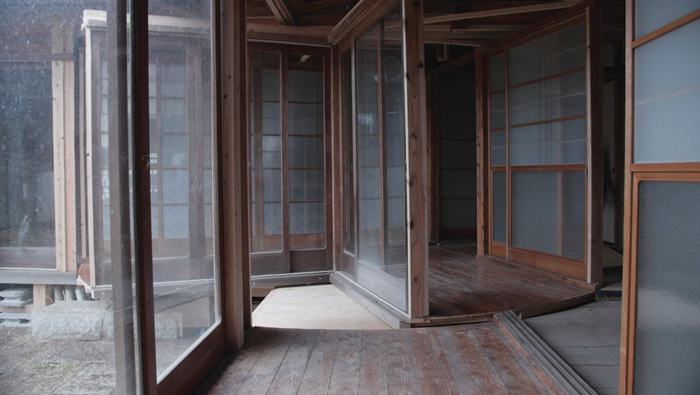
In the project, Mochida cut out a part of the house in circle, and made viewers to push and rotate the circle. Japanese houses are basically build based on standard unit formats. In other words, even if the part of the interior space will be cut out and rearranged to different part of the house, the dimension still somehow matches. But still, it was a unique experience to see strange situations with a tatami mat space becoming an corridor (corridors usually will not have tatami) or corridor suddenly appears right in front of alcove by pushing and turning around the circle little by little. Every push made unexpected collision of different function of the space which we never saw before. By the exhibition, the house was made open to public, and the public viewers would help, with their push, to make the private interior space to touch the open air outside the house.
Mochida participated in the Reborn-Art Festival in 2019 and realized a project in Aji Island, Ishinomaki in Miyagi Prefecture. After the Great East Japan Earthquake, many vacant houses in the area had to be demolished. However, properties whose owners were not known or some with specific reasons are left vacant without a resident. As the artist says, the houses are "floating in the air" without any owner. Mochida's project in Reborn-Art Festival was to visually lift up a house off from the ground. Around at the same period, the artist was preparing also for her projects for Norther Alps Art Festival and Sapporo International Art Festival. Norther Alps Art Festival was originally planned to be held in the early half of 2020, but had several postpones due to Covid-19 till it was finally opened in the end of 2021. The work presented in this exhibition, "A Clash (or a Rift)" was one of the most striking work among the series of recent projects using house as a material, Revolving House and Floating House, by the same artist.
The artist used two houses on a mountainside. One house had been cutout and the "slice" of it was thrusted away to another house in the back side. All the furniture, even curtains was still left as it was as if someone has still being using the house till the right moment before a mysterious incident making the house blow away to strike the other. We have not seen this type of work by the same artist, well showing the exquisite balance between the dynamic momentum showing the "movement", along with the "stillness", a sudden stop of the motion sitting in silence. For a careful viewer, the work can be read as very site specific work as the venue Ohmachi is the area where Itoigawa-Shizuoka Tectonic Line runs to split the Japanese central island in two from Japan Sea to the Pacific. We frequently see site-specific projects in exhibitions rooted to local area, but I was able to understand the ability of the artists to sublimate the characteristic of the site into an strong work.
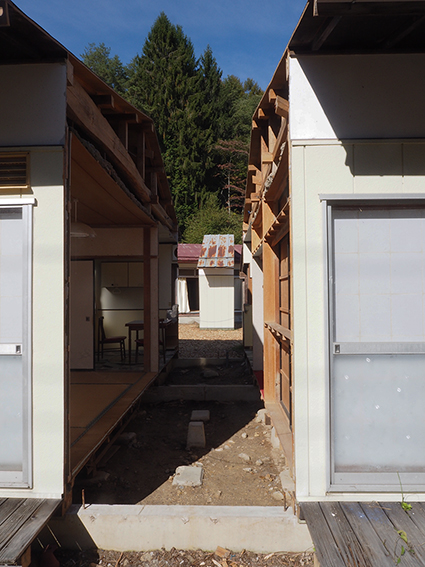
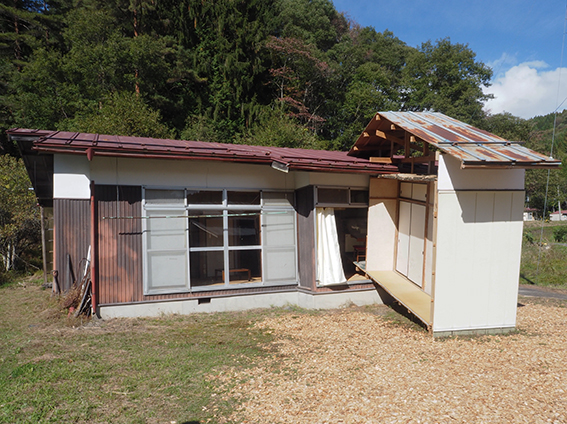
For Sapporo International Art Festival, the artist was planning to install a huge staircase at Moerenuma Park, notable for Isamu Noguchi's design. The prototype for the installation can be found in the works in Rokko (2014 for Rokko Metts Art) and Havana (2018, in an exhibition organized by Japan Foundation).(*4) Unfortunately, Sapporo International Art Festival itself was canceled due to Covid-19 in the end. But we are able to see from the officially released plan in the website, how the stairs are raised up to reach the very highest peak considering the viewers' actual movement of the body. We can sense that the work should have been beautiful if it was realized. (*5)
Atsuko Mochida's work creates a new magnetic field from existing venues or relationships with the audience. Perhaps the most important element in the artist's works are the given condition of the space. What kind of devise can be effectively applied to the existing site to draw out an invisible power? The most interesting part common in Mochida's work is her way to drive out the invisible power of the site from the existing site or to have the audience participate in the work to make the site specific. On the other hand, what can this artist do in a neutral space like in museums? Perhaps, she will be able develop a new method for new type of exhibition space as she done in previous years. And at the same time, along with the issue of sites, there is a difficult question of how to find more chances and also a way to raise funds make projects possible. There are difficult issues which all the installation artists shall face, who usually have to dismantle the project every time after the exhibition and have to create a new different piece in all the different situation. We always question if there is a better format we have not experienced in order to systematically organize an exhibition for these kind of installation artists. Sooner or later, we shall need to invent a new system of exhibition to make these artist possible to survive.
Toshio Kondo, ArtTank
notes
*1 Sapporo International Art Festival 2020 was canceled due to COvid-19.
*2 Norther Alps Art Festival 2020 was to happen in the Summer of 2020, but postponed due to Covid-19, and finally happened as Norther Alps Art Festival 2020-2021.
*3 Perhaps a painting "Stairway" by Oskar Schlemmer (1888-1943) who was teaching in Bauhaus is the most noted staircase in Bauhaus. However, the staircase in Schlemmer is the one in Dessau designed by W. Gropius. There is another notable staircase in Bauhaus designed by Henry van de Velde in Weimar where Gropius took over Bauhaus from van de Velde. Staircase in Weimar is a spiral staircase and Art nouveau style.
*4 Mochida made the first staircase in 2013 in an apartment in Tokyo using steel pipes for construction scaffoldings. In 2018, the artist made a staircase in Havana for the exhibition program organized by japan Foundation, and in the same year, the foundation made an returning exhibition in Aoyama Spiral in Tokyo for the artists. Though Mochida had to use scaffolding steel pipes in Tokyo again, the work in Havana was not made of steel pipes, but different unit of steps which was closer to the delicate spiral shape Weimar rising higher upward.
*5 Later, work with the staircase format which reminds us of the plan in Sapporo was shown in Terrada Storage exhibition in Tokyo (2021). In this exhibition, the staircase looked more like a sculpture due to the restriction of the given space, though the artist originally wanted to make it more organic. For the exhibition in Terrada exhibition, the artist was showing the work along with the drawing to show the system of staircase at the moment temporary stocked in a storage ready to be developed freely according to any other possible sites in the future. This work of staircase units shall indeed be assembled in a different shape depending on the condition of the space and will give different meanings according to the site. We can see from the drawing in Sapporo that the work should look more "organic" as viewers naturally would led to see upward toward the natural sunlight coming in from above.
